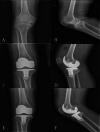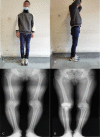Total knee arthroplasty in patients with haemophilic arthropathy is effective and safe according to the outcomes at a mid-term follow-up
- PMID: 35819639
- PMCID: PMC9276882
- DOI: 10.1186/s10195-022-00648-5
Total knee arthroplasty in patients with haemophilic arthropathy is effective and safe according to the outcomes at a mid-term follow-up
Abstract
Background: Haemophilic arthropathy (HA), a common complication of haemophilia, is secondary to recurrent joint bleeding and increases the prevalence of end-stage osteoarthritis (OA). Total knee arthroplasty (TKA) is a reliable treatment for haemophilia patients. This study was performed to evaluate the mid-term outcomes of TKA for end-stage HA. We hypothesized that the rate of complications of TKA is higher for patients with haemophilia than for patients without haemophilia.
Methods: Patients with HA undergoing TKA from January 2015 to December 2016 in our centre were retrospectively reviewed. All patients were managed by a multidisciplinary team. The improvements in flexion contracture, range of motion (ROM), Knee Society Score (KSS; clinical and functional), Visual Analogue Scale (VAS) score, and satisfaction at final follow-up were analysed to evaluate the effectiveness of TKA in HA. The complications were analysed to evaluate the safety of TKA in HA.
Results: Twenty-eight patients (32 knees) were included in the study. The follow-up was 69.1 ± 5.1 months. Significant differences between the preoperative and final follow-up values of flexion contracture (which changed from 21.1 ± 6.5° to 14.3 ± 4.1°, P < 0.001), ROM (from 53.9 ± 15.0° to 70.3 ± 16.3°, P < 0.001), clinical KSS (from 33.5 ± 14.4° to 62.7 ± 9.5°, P < 0.001), functional KSS (from 46.1 ± 15.5° to 62.9 ± 9.7°, P < 0.001), and VAS score (from 6.8 ± 1.4 to 4.9 ± 1.3, P < 0.01) were observed. Importantly, the incidence of complications was 15.6% and the satisfaction was 100% in our mid-term study.
Conclusion: Under elaborative and comprehensive management, TKA is effective and safe in patients with advanced HA on the basis of mid-term follow-up outcomes.
Keywords: Arthropathy; Haemophilia; Mid-term outcome; Total knee arthroplasty.
© 2022. The Author(s).
Conflict of interest statement
The author(s) declare no potential competing interests in the research, authorship, and/or publication of this article.
Figures






Similar articles
-
Total hip and knee arthroplasty in HIV- and HCV-positive hemophilia patients: short term follow-up of 14 patients.BMC Musculoskelet Disord. 2023 Dec 6;24(1):946. doi: 10.1186/s12891-023-07087-1. BMC Musculoskelet Disord. 2023. PMID: 38057748 Free PMC article.
-
[Impact of Preoperative Knee Stiffness on the Postoperative Outcome after Total Knee Arthroplasty in Patients with Haemophilia].Z Orthop Unfall. 2015 Oct;153(5):526-32. doi: 10.1055/s-0035-1557768. Epub 2015 Oct 9. Z Orthop Unfall. 2015. PMID: 26451861 German.
-
Total knee arthroplasty for severe haemophilic arthropathy: long-term experience in Taiwan.Haemophilia. 2008 Jul;14(4):828-34. doi: 10.1111/j.1365-2516.2008.01693.x. Epub 2008 May 22. Haemophilia. 2008. PMID: 18510565
-
Mid-term outcomes and complications of total knee arthroplasty in haemophilic arthropathy: A review of consecutive 131 knees between 2006 and 2015 in a single institute.Haemophilia. 2018 Mar;24(2):299-306. doi: 10.1111/hae.13383. Epub 2017 Nov 29. Haemophilia. 2018. PMID: 29193440 Review.
-
Total joint arthroplasty in haemophilia.Haemophilia. 2000 Sep;6(5):474-81. doi: 10.1046/j.1365-2516.2000.00443.x. Haemophilia. 2000. PMID: 11012688 Review.
Cited by
-
A Retrospective, Long-term Follow-up of the Clinical Outcomes and Cost-effectiveness of Single-anesthetic Multiple Total Joint Procedures in Hemophilic Arthropathy.Orthop Surg. 2023 Jun;15(6):1670-1676. doi: 10.1111/os.13743. Epub 2023 May 5. Orthop Surg. 2023. PMID: 37143443 Free PMC article.
-
Efficacy of corticosteroids addition to multimodal cocktail periarticular injection in total knee arthroplasty with hemophilic arthropathy.Sci Rep. 2025 Apr 22;15(1):13881. doi: 10.1038/s41598-025-96713-0. Sci Rep. 2025. PMID: 40263493 Free PMC article.
-
Continuous femoral nerve block as pain management following total knee arthroplasty: a systematic review.Arch Orthop Trauma Surg. 2025 Apr 11;145(1):238. doi: 10.1007/s00402-025-05855-3. Arch Orthop Trauma Surg. 2025. PMID: 40214694
-
Total Shoulder Arthroplasty in Patients With Hemophilia A: Greater Odds of Postoperative Bleeding and Thromboembolic Events but No Difference in 5-year Implant Survival.Clin Orthop Relat Res. 2025 Feb 1;483(2):268-275. doi: 10.1097/CORR.0000000000003209. Epub 2024 Sep 3. Clin Orthop Relat Res. 2025. PMID: 39246053
-
Physical therapy for end-stage hemophilic arthropathy: a case report.BMC Musculoskelet Disord. 2023 Nov 27;24(1):916. doi: 10.1186/s12891-023-07056-8. BMC Musculoskelet Disord. 2023. PMID: 38012586 Free PMC article.
References
MeSH terms
Grants and funding
LinkOut - more resources
Full Text Sources
Medical

